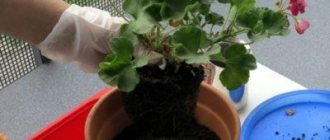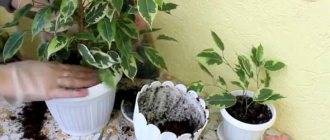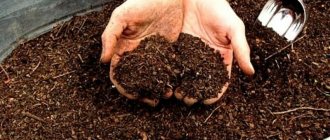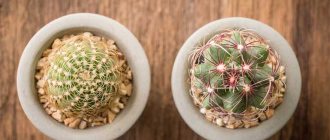Is it possible to plant like this?
Due to the ability of geranium to survive and continue to grow even in unfavorable conditions, it can be propagated without the use of roots. But in general there are three ways to propagate this crop:
- seeds;
- division of roots;
- cuttings.
The first method takes too much time and patience, because in order to germinate the seeds, you need to provide strictly defined conditions, the second is quite risky, since the delicate roots are very easy to damage during their division, but the third, by cuttings, is preferred by most people involved in growing and breeding geraniums.
The main advantage of this method is the ability to propagate a plant without disturbing its roots, which guarantees the complete safety of the mother plant.
Propagation by cuttings gives almost one hundred percent positive results in a relatively short period of time.
How does rooting occur?
Geraniums are propagated in different ways, but often by cuttings, when existing plants are used.
The plant can be rooted in water and soil. Experienced gardeners believe that the process of formation of the geranium root system occurs faster in the soil, but a more viable root is formed in water.
If cuttings are rooted in the ground, you must take into account the requirements:
to cuttings;- to the ground.
How to take cuttings correctly:
- Use only strong and healthy cut shoots.
- The lower leaves are removed.
- Cut cuttings 7-10 cm long.
- Cuttings are made between two leaves.
- At the bottom, the cut should be made below the bud, without leaving the stem, which can rot in water.
- At the top, the cut is made above the bud, without leaving a stem above it, so that the new shoot does not grow to the side and not up.
- The sections must be dried for two hours to form a protective film.
What soil to use:
- The soil should not be very dense. The ideal composition would be: peat (three parts), perlite (one part).
- In addition, rotted compost and pre-calcined soil from the garden should be added to the soil mixture.
Reference. Vermiculite, brick chips, fine expanded clay, foam chips and sand can replace perlite as leavening agents. But you need to know that the composition with expanded clay cools faster in the cold and heats up in the heat.
As soon as the cuts are dry, you can start planting:
- It is better to put drainage at the bottom of the container.
- Sprinkle soil mixture on top.
- Make a hole in it and place the seedling.
- Compact the earth a little.
- Then water until slightly moist.
After three to four weeks, roots should appear.
More details about how to propagate geraniums by cuttings at home can be found here.
What is a cutting, how to choose and prepare it correctly?
A shoot, or cutting, is a cut part of a plant with one or more nodes. This cut off part is precisely used for vegetative propagation (by cuttings). In order to get a new geranium, completely identical to the previous one, you first need to select this cutting.
When should you take a cutting from the mother flower in order to plant and grow a young plant? The mother plant should be well developed and absolutely healthy, ideally it should be 2 - 3 years old. You need to select the apical cuttings of the mother geranium. This process should be 7–8 cm in length, have one or more nodes (buds, growth points) and 3–5 leaves. If there are leaves left at the base of the cutting, they must be carefully removed.
If the branches of the shoot are the same length as the shoot itself, then you definitely need to cut them off, and then you can use them as independent cuttings. And the finished shoots are left in the air so that the cut areas dry out. If after a few hours they are covered with a thin film, it means that everything went well and the cuttings are ready for the next stage.
Some gardeners recommend sprinkling the cut areas with crushed activated carbon and leaving the cuttings in a dark place for a day.
Caring for the shoot
Transplanting a geranium shoot into a large pot
When young leaves appear, after two to three weeks, it is permissible to plant the geranium in a larger pot or move it to a permanent place, on the windowsill. When creating comfortable conditions for a young plant, monitor the main parameters:
- sufficient illumination - about 16 light hours;
- optimal air temperature is 15–25 degrees;
- regular, moderate watering - once a week.
How to carry out the procedure?
The cut shoots do not yet have roots, which are necessary for the development of full-fledged geraniums, so after their preparation it is necessary to root the cuttings. This can be done in water or directly in the prepared substrate.
Rooting cuttings in water
How to propagate a plant by placing cuttings in water? The main advantage of this method is the ability to observe the process from beginning to end and not miss the moment when the shoot has roots and can already be planted in the substrate.
Prepare a small transparent container (disposable cups work great).- Pour settled water at room temperature into a container up to about half a glass (5 cm).
- Place the shoots in water.
- Change the water once every 2 days.
- After about a week (during this period the first roots should appear), transplant the rooted cuttings into the prepared substrate in a container of a suitable size.
Rooting in water also has its significant disadvantage: sometimes the cutting can rot before it even takes root, and in order to prevent this, gardeners strongly recommend adding crushed activated carbon to it for disinfection every time you change the water.
Using this method, you can get beautiful and healthy geraniums.
Rooting in the ground
Is it possible to plant a cutting without roots directly into the ground? Thanks to rooting in the ground, you don’t have to worry about the shoots rotting, since this happens extremely rarely, but you won’t be able to see when the roots will appear, which is why the planting material sometimes gets spoiled by being replanted ahead of time. How to plant correctly can be read in the instructions:
Prepare a substrate from garden soil and peat.- Place the prepared soil in a small container, moisten it generously and compact well.
- Choose a place with sufficient diffuse lighting. Cuttings really do not like scorching rays.
- Place the shoot into the substrate to a depth of 4–5 cm and again compact the soil around it.
- Waiting for new leaves to appear on the cuttings means that it has successfully taken root and is ready to be transplanted into a full-fledged pot. This will take about a month.
Geranium propagation
Gardeners and flower growers are most familiar with plants from the genus Geranium and the genus Pelargonium. Geraniums are ubiquitous in the wild and in gardens, while Pelargoniums are most often found in homes as potted plants. These natives of Africa can only exist in the open ground during the summer months. Indoor pelargonium is mistakenly called geranium.
Both geranium and pelargonium reproduce in two main ways:
- generative, that is, seeds
- vegetative, that is, various parts of an adult plant
Not all geraniums can be propagated by seeds. This method is used in amateur propagation of geraniums and pelargoniums with simple, non-double flowers. To propagate varietal and hybrid geraniums, they use the vegetative propagation method.
Of the vegetative methods of propagation, propagation by rooted shoots is most suitable for indoor royal, fragrant and some zonal geraniums. Important! Indoor geranium can grow in a pot for up to 10 years.
However, the flower very often stretches out, the lower part of the stem becomes bare and the plant loses its attractiveness. An elongated flower has to be grown again by cutting off a cutting from it and rooting it in any way. In addition, rare species can be propagated by shoots, which are quite expensive to buy in the store.
Transplanting into a pot: when and how?
Rooting a geranium cutting in water on average takes no more than a week, so after 7 days, as soon as the roots appear, you need to replant the plant so that it begins to grow fully.
A cutting that is placed in the ground produces roots only after a month, but unlike the method with water, the roots will not rot, so the likelihood of getting a new plant is very high.
- Remove the cuttings that have taken root from water or soil.
- Prepare the substrate: 2 parts turf soil, 1 part sand, 1 part humus, 1 part leaf.
- Choose the right size container: shallow and quite wide, because geraniums have a shallow root system.
- Place good drainage at the bottom of the pot.
- Place soil in a container and moisten it.
- Plant the sprout in the substrate and compact the soil around it a little.
- Place the pot with the plant on a well-lit windowsill.
A cutting rooted in water is replanted after a week, and one rooted in the ground after a month.
The dates presented above are approximate , so first of all you need to look at how the process develops.
Read our special materials about planting geraniums, including in the country, as well as about transplanting them into another pot.
Methods for rooting a shoot
Roots can form in water or soil; the choice of method depends on the type of plant, time of year and the desires of the grower. If we let the cutting sit in water for too long, it may rot. For example, royal geraniums form roots in 35–40 days, which means this method is not suitable for them.
In water
The cuttings are placed with a dried cut in water (at a level of 4 cm). It is better to take an opaque container and disinfect it before use. The water should be soft, clean, settled, at room temperature (+22...+24 °C), it should be changed after 1–2 days. Some gardeners argue that you cannot change the water when rooting cuttings - they say, it’s better to just top it up. To reduce the risk of stem rotting, you can add crushed activated carbon.
The dishes with the appendage are placed in a lighted place, avoiding direct sunlight. Daylight should last at least 16 hours, and at night the temperature should not drop sharply. With this method, it is convenient to observe the growing roots, and you can easily determine the moment of planting in the ground.
In the ground
If you know how to plant a varietal geranium with a shoot without roots directly in a pot with soil, you can quickly wait for a new plant. Planting of prepared geranium shoots should be carried out in nutritious, loose, slightly acidic soil to a depth of 1.5–2 cm. Experienced gardeners make a soil mixture of drainage soil, peat and sand, sometimes adding vermiculite. A layer of expanded clay is poured into a pot with drainage holes, then soil, and a small layer of sand is added on top, which provides some protection from waterlogging of the base of the cutting.
The soil must undergo a disinfection procedure. To do this, it is heated in the oven for 20–30 minutes or poured with a hot solution of potassium permanganate. The pot must also be disinfected before use. It is recommended to use formalin or just boiling water. Make a hole in the middle with a pencil, place the cutting, and press the soil tightly against it.
It is not recommended to cover cuttings planted in this way with a jar or plastic wrap, but this can be done if the leaves begin to dry out along the outer edge. After the leaves are restored, the jar is removed. The dishes with the shoots are placed in a bright, warm place - it can be a window sill, but without the drying effect of the central heating radiator and without direct sunlight. Water them moderately after the top layer has dried. For watering, use clean water at room temperature and a watering can with a narrow spout, directing the water to the ground so that it does not fall on the leaves and stem. Overwatering threatens the appearance of blackleg, which means the loss of the plant.
The appearance of new leaves signals that the plants have taken root. This may happen after a week or even after 3 weeks. From this moment they can be transplanted to a permanent place of growth.
Further care
Knowing how to plant geraniums without roots, gardeners often propagate varietal plants purchased at a high price. Plants rooted in water or soil are planted in pots or boxes with a mandatory drainage layer and nutritious loose soil. Caring for them includes creating comfortable conditions with the necessary amount of light, suitable air temperature, sufficient watering and regular feeding.
So, at home, young plants are most often placed on window sills. They can also be used to decorate balconies, galleries, and be planted in flower beds in the summer. The main thing is to provide the plants with at least 16 hours of daylight and protect them from direct sunlight, even when planted outside.
Geranium does not like moisture on its leaves; it must be protected from this by spraying neighboring plants, and it must be watered so that the stream of water is directed towards the walls of the pot. Young, recently rooted plants are often watered using the bottom method - placing them in a pan of water for 0.5 hours.
It is important to monitor the looseness of the soil, because the roots of pelargonium love to receive fresh air constantly. Fertilizing is carried out with special complexes of mineral fertilizers (for example, “Pelargovit”) no more than every 2–3 weeks, simultaneously with watering.
In order for plants to form lush bushes, they need to be carefully pinched with clean hands or disinfected scissors, treating the cut areas with activated carbon.
When can a flower be propagated in this way?
Geraniums can be propagated by cuttings all year round, but flower growers are of the opinion that during the dormant period (mid-autumn - end of winter) it is better not to touch the plant, because at this time it is very vulnerable, and therefore the mother geranium may die. Therefore, the most optimal period is spring, when geraniums begin their growing season and are still full of previously accumulated strength.
Propagation of a plant such as geranium is a fairly simple process that anyone who takes it upon can do it. And proper and timely care for a rooted plant will help it delight the eye with its attractive and aesthetic appearance.
Growing geraniums from cuttings at home. How to grow geranium
Geranium is a very unpretentious plant. It can grow and bloom in such terrifying conditions that you are amazed. And yet, if she is provided with the necessary conditions, she will thank the owner with abundant flowering and gorgeous foliage.
- Geranium grows well in neutral or slightly acidic soils, with the addition of a small amount of sand and peat. If you are going to grow it on the plot, you need to add a handful of humus to the hole.
- To grow in a pot and in the ground you need good drainage.
- For planting, choose a small pot, otherwise the root system will not allow the plant to bloom until it grows.
- Geranium is very light-loving. In the shade, it quickly stretches out and exposes the branches.
- The plant grows and blooms very well in the air, so in summer it is advisable to take it out onto the balcony. In direct sunlight, the leaves may turn pink - this is not a problem. Sometimes geranium leaves turn red from contact with cold glass on the windowsill in winter. In this case, move the pot away from the glass.
- Geraniums are watered regularly in summer and spring, avoiding allowing the soil to dry out. In winter, watering is adjusted depending on the room temperature.
- It is not recommended to spray or wash geranium leaves, as they are covered with fluff. In exceptional cases, you can rinse the bush under running water from the shower if it is very dusty. Dust is usually removed by brushing off the leaves with a soft paint brush.
- The plant blooms better if old inflorescences are removed in time.











